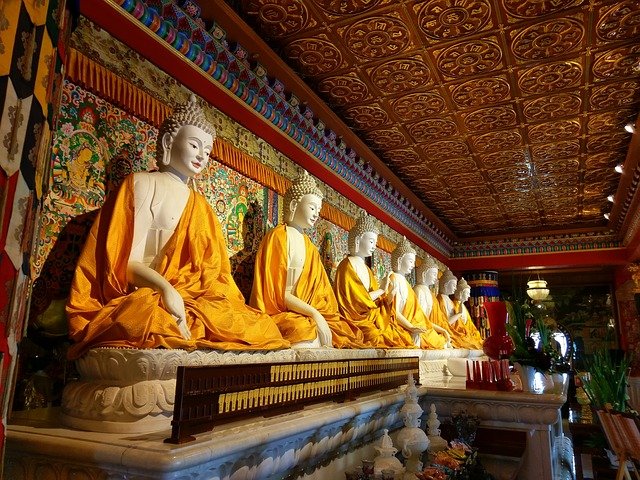If you’ve come this far to find out how to be a Buddhist, you’re probably interested in one of the oldest philosophical and religious doctrines in the world. And also one of the most followers accumulates. Did you know that today there are more than 500 million people around the world who practice Buddhism?

Even many celebrities have been seduced by this cult. The case of Richard Gere, Angelina Jolie, Keanu Reeves and even the Spanish Penélope Cruz is unknown to no one. They are just some of the celebrities who have openly declared to follow this religion and its philosophical doctrines.
But what really is Buddhism and what do you have to do to be a Buddhist? We are going to explain everything you need to know. Let’s go by parts.
What is Buddhism?
Buddhism is considered a philosophical and religious doctrine that brings together a large number of spiritual beliefs and practices. These spiritual practices are associated with the figure of Buddha or Siddharta Gautama. Buddhism was created precisely on the teachings of this sage. This religion was founded by Buddha in the 5th century BC and derived from the Sramana movement.
Today Buddhism is the fourth largest religion in the world and is practiced by more than 7 percent of the population.
Buddhism was born in India, where most of its practitioners are found. From there it began to spread to East Asia. This doctrine had many adherents until the Middle Ages, at which time it began to decline.
Buddhism is divided into two major branches.
- Theravada, which literally means School of Elders. This branch has as its final objective to reach Nirvana, the highest spirituality, through the practice of the Eight Noble Truths. Through these truths, the human being is able to free himself forever from the cycle of suffering and rebirth. Today Theravada is practiced in Southeast Asia and Sri Lanka.
- Mahāyāna, which means The Great Path. This branch is well known in East Asia and there are many faithful who practice it. Instead of trying to reach Nirvana, the Mahāyāna tries to reach the state of Buddha. In this state, human beings are able to permanently maintain themselves in a state of rebirth in order to help other human beings to reach the Buddhist path.
Who was Buddha?
Today the story of Buddha is not completely known. It is unknown if he was a nobleman or a prince and even if he actually came into existence. The Buddha was originally known as Siddhartha Gautama of the kṣatriya caste of Hinduism. This, considered the second Hindu caste, was made up of warriors and nobles.
According to the texts that we have about Buddha, it seems that he was born in a small town near the current border of Nepal. This village was Kapilavatthu. But Buddha did not stay there, he settled in different places. Mainly in Bihar and Uttar Pradesh.
His teachings were transmitted from generation to generation orally until they began to be compiled in writing in the Pāḷi Canon. However, in this text Siddhartha’s teachings appear scattered. His biography would not be adequately written until many centuries later. The most recognized biography of Siddhartha is the one written by the Hindu teacher and scholar Aśvaghoṣa in the first century AD.
As you can see, being a Buddhist is not an easy path and requires a lot of studies and knowledge. Next we are going to explain what are the steps to follow to know how to be a Buddhist. Let’s get started!
What do you need to be a Buddhist?
- Read the next article
- Pay attention to these tips
- Take it seriously. Buddhism is a complicated doctrine but one that offers many joys to its followers. If you really want to learn how to be a Buddhist, you will have to study hard.
Instructions to be a Buddhist
- Understand its meaning and the main words of this philosophical doctrine. Buddhism can be complicated even in its terminology. There are many concepts associated with little-known words in our language. Do not forget that Buddhism is Hindu. Therefore its main terms come from this language. Let’s see the best known.
- Arhat. Arhat is considered to be that being who is capable of reaching Nirvana thanks to Buddhism.
- Bodhisattva. This term refers to that being that has not yet reached Nirvana. That is, he is still on the path of enlightenment.
- Buddha. He is the ascetic for whom this philosophical doctrine is named. He is characterized by being considered as that being who has managed to reach full enlightenment.
- Dharma. This term refers to the teachings of the Buddha.
- Nirvana. It is the end of Buddhism, at least that of the Theravada branch. We can understand nirvana as the supreme and pure spirituality.
- Learn to differentiate the two main branches of Buddhism. Buddhism is a complex religious and philosophical doctrine that has many widely disparate branches. However, as we have explained a few lines above, Buddhism is mainly divided into two branches the Theravada, which seeks Nirvana as its end, and the Mahāyāna, whose purpose is to reach the state of Buddha. That is, of being that reaches full illumination. The best way to learn about the different branches that make up Buddhism is to spend time studying this doctrine that is thousands of years old.
- Learn all you can about the Four Noble Truths. The first speech that Gautama Buddha gave to his friends is known under the name of The setting in motion of the wheel of dharma. In this discourse, Buddha spoke for the first time of “The Four Noble Truths”. These are the bases on which existence is established. Broadly speaking, these are:
- Duhkha. In life there is suffering, discontent and dissatisfaction. This reality is known under the term of Duhkha. This teaching explains that life is not perfect and that suffering, whether we like it or not, exists.
- The tṛṣṇā. The origin of suffering is enclosed in the desire and longing to want more. This is known as the tṛṣṇā. Desires and sensual pleasure, everything that makes us seek pleasure here and now, causes this suffering.
- There is a cessation of duhkha. But we can put an end to this suffering if we remove from the equation what makes us suffer. If the craving for sensual pleasures is abandoned, suffering ceases. You have to face the duhkha directly to stop the tŗşņā.
- Attain the noble eightfold path. This path prevents the appearance of suffering. If we follow it, we move away from the path of dissatisfaction. To follow this path, extremes must be avoided.
- Understand the principles of Karma. In Buddhism any intentional action is known as Karma. If you are not sure what this means, there is a television series that explains it very well: My name is Earl. In this comedy the main character tries to undo all the evil that he has done in his life in order to balance his karma. Karma can be divided into “good” and “bad” karma depending on the actions we take. In karma also lies the fact that we have a more or less happy life because our actions will always have consequences
- Meet the Renaissance. The rebirth is similar to the reincarnation of other cults that occur in India and the rest of the world. The difference between both concepts is that rebirth does not affirm that there is a soul that endures and can transmigrate. For example, unlike what happens with other cults regarding reincarnation, the end of life is not rebirth. It is part of the experience that allows each being to free themselves from the chains of causes and effects experienced through karma.
- It reaches enlightenment or Nirvana. This is the true goal of Buddhism. Getting awaken from Samsāra, a cycle made up of repeated awakenings between death and rebirth. Nirvana is reached when the cycle is finally closed and the being is able to experience the true nature of life and existence itself. This reality is expressed in the Buddha’s teachings through The Four Noble Truths. The guide that every person needs to be able to reach Nirvana. These truths direct us to the right path to finally reach enlightenment.
Tips to be a Buddhist
Read about the life of Siddharta Gautama. We have explained when talking about the Buddha that his teachings were transmitted from generation to generation orally. It took until the first century AD to have a biography of the Buddha. This was written by the Hindu scholar Aśvaghoṣa. You may not find a proper translation of this text but today there are many books on the market about the life of Siddhartha. There are also about the principles of Buddhism. Look in your library or in your neighborhood bookstore and start training!
